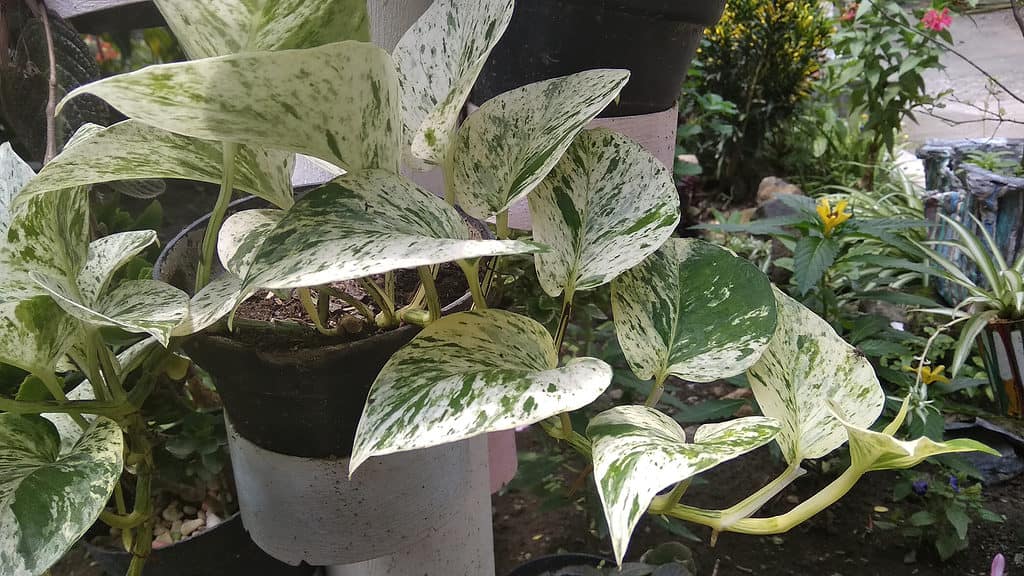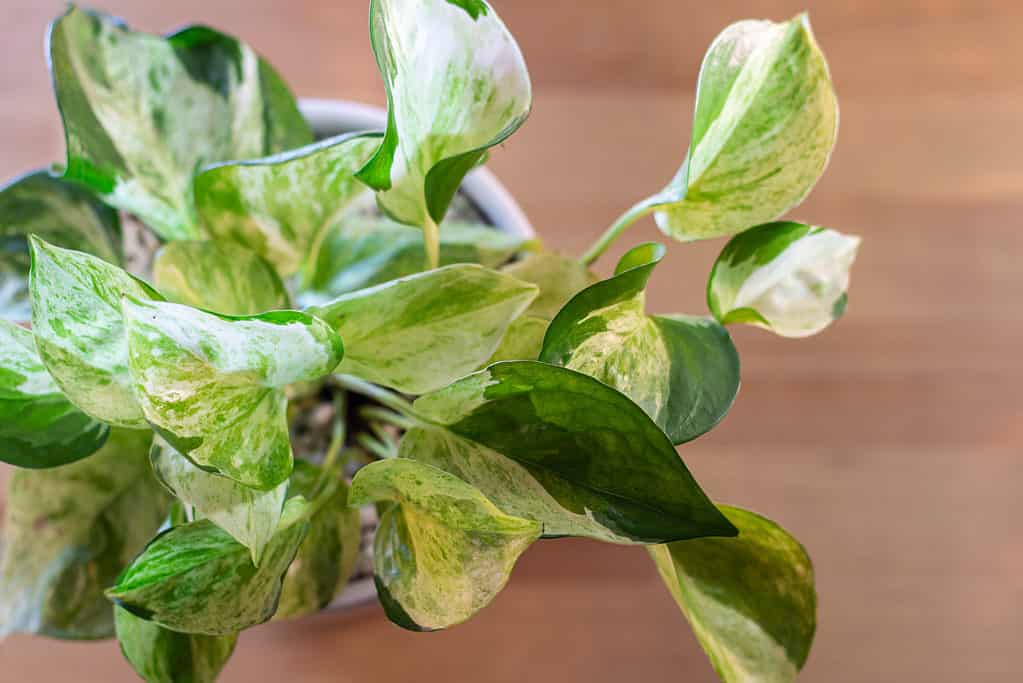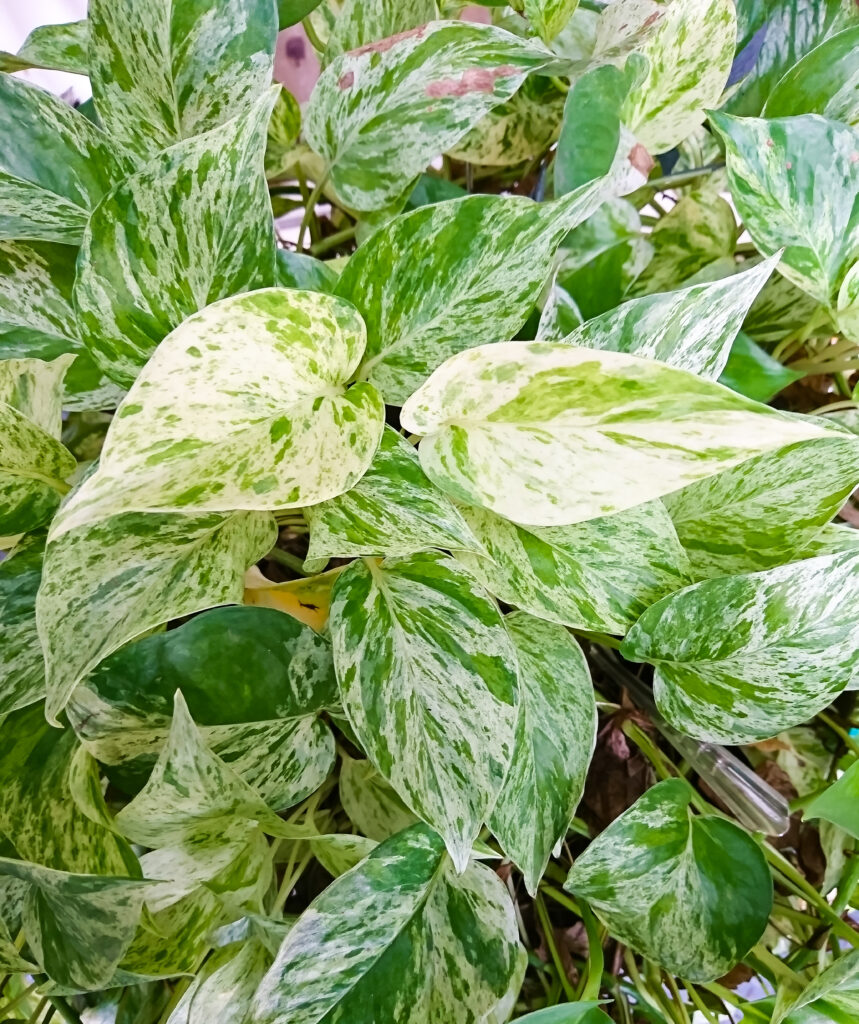Variegated pothos, or pothos plants with multicolored patterns on their leaves, are very popular cultivars in the plant trade. There are dozens of different variegated pothos varieties, but two beloved (and rare) cultivars we’ll talk about today are the snow queen pothos and harlequin pothos. But don’t hold your breath on being able to find these varieties easily; they are two of the most difficult-to-find pothos varieties out there.
If you haven’t worked with many variegated pothos plants, you might find it difficult to tell these two beautiful plants apart. However, they are distinct varieties with some notable differences. Let’s break down some of these differences and how to care for your own variegated pothos plant.
Comparing Snow Queen Pothos vs. Harlequin Pothos
| Snow Queen Pothos | Harlequin Pothos | |
|---|---|---|
| Classification | Epipremnum aureum ‘Snow Queen’ | Epipremnum aureum ‘Harlequin’ |
| Alternative Names | N/A | N/A |
| Origin | South Pacific Islands | South Pacific Islands |
| Description | A variegated type of pothos that has very bright white, cream, or pale green patterns on its foliage. | A very rare type of variegated pothos with strong, almost completely white leaves with very little chlorophyll. |
| Uses | Ornamental Plant | Ornamental Plant |
| Growth Tips | Give your snow queen pothos plenty of bright, indirect sunshine, or even consider planting it outdoors for better sun exposure. | Wait for the top 50% of the soil to dry out before watering this plant, as it is quite drought-tolerant but cannot handle soggy roots. |
| Interesting Features | The variegation of this pothos variety lacks the mid-green or yellow hues of other varieties and instead boasts almost completely white leaves. | Similarly, the harlequin pothos’ variegation makes it appear almost completely white, though its leaf shape is more similar to a Manjula pothos. |
The Key Differences Between Snow Queen Pothos and Harlequin Pothos
The snow queen pothos and the harlequin pothos are two very similar plants. They are actually the same species of pothos, but are separate varieties.
The biggest differences between these two plants come down to their leaf variegation, patterns, and colors. The snow queen pothos has mostly white variegation against dark or mid-green leaves. The white speckled or splash-like patterns of this variety take up a vast majority of the leaf. The harlequin pothos is unique in that it does not have a lot of speckled or splash-like variegation. Rather, the white or cream variegation of the harlequin pothos takes up huge chunks of each leaf. The variegation of the harlequin pothos is so intense that it engulfs most of the leaf and makes it look like a pure-white leaf with a few stripes of green. The snow queen pothos has pointer leaves when compared to other pothos varieties as well.
With this difference in variegation comes slight differences in each plant’s care. Both absolutely need indirect, bright sun in order to keep their patterned appearances. However, the snow queen pothos is just slightly more tolerant of low light when compared to the harlequin pothos. The variegated parts of both plants completely lack chlorophyll. As a result, both plants absolutely need sunlight in order to survive, or else they will revert back to fully green (and not as cool-looking) plants.
The snow queen pothos is also much easier to find when compared to the harlequin pothos. You may not be able to find a true snow queen at your local garden center or nursery, but you’ll have some luck searching online nurseries. The harlequin pothos, alternatively, is extremely difficult to find. It is also often mislabeled as well.
With these differences in mind, the snow queen pothos and harlequin pothos have identical care requirements. They both require plenty of indirect, bright sunshine in order to keep up their unique variegation.

The marble queen pothos (pictured) is the parent plant of the snow queen pothos.
©Rezqiano/Shutterstock.com
Snow Queen Pothos vs. Harlequin Pothos: Classification
The botanical name for the snow queen pothos is Epipremnum aureum ‘Snow Queen’. The botanical name for the harlequin pothos is Epipremnum aureum ‘Harlequin’. Both varieties share the same genus, Epipremnum.
Snow Queen Pothos vs. Harlequin Pothos: Description
The snow queen pothos is a unique cultivar of the golden pothos with dramatic variegation. It is commonly mistaken for the marble queen pothos. While the two plants are different, it is thought that the snow queen pothos is a direct ancestor of the marble queen pothos. The snow queen pothos has unusual and very colorful white-green variegated leaves. The plant’s leaf has a marbling-like appearance due to white and green specks. The bulk of the leaf is covered by the white patterns, giving it an almost all-white appearance. Because of this, the snow queen cultivar has an extremely low chlorophyll content and needs plenty of sunshine to live. Due to its excellent decorative value, the snow queen pothos soon became a favorite among indoor plant enthusiasts when it was first introduced.
The harlequin pothos is an extremely rare variegated variety of pothos. This cultivar, which was developed for its low maintenance requirements, attractive leaves, and outstanding air-purifying capabilities, does pretty well with proper care. It’s possible that harlequin pothos are simply Manjula pothos varieties with a lot of variation. Some gardeners have drawn this conclusion from the plant’s characteristic white variegations which could be a result of propagating techniques. The distinctive name of this member of the Araceae family comes from its foliage’s huge white variegated areas and light green accents. The harlequin pothos’ size varies based on its growth environment and level of attention.

The Manjula pothos (pictured) is likely the parent plant of the harlequin pothos.
©Catherine Tribone/Shutterstock.com
Snow Queen Pothos vs. Harlequin Pothos: Uses
Snow queen pothos and harlequin pothos are both used as houseplants or decorative ornamental plants. In the appropriate hardiness zones, they can also both be used as landscaping plants to add foliage to trees or to be used as ground cover.
Snow Queen Pothos vs. Harlequin Pothos: Origin
The original golden pothos species is native to the South Pacific Island and many coastal regions of Asia. They are also naturalized in Australia, Puerto Rico, Hawaii, and much of French Polynesia.
The snow queen pothos’ past is mostly unknown. When it comes to who initially bred the snow queen cultivar or even who first patented it, there isn’t a lot of trustworthy information available online. It is generally acknowledged that the snow queen pothos was probably created by the natural genetic mutation of the marble queen pothos because of the genetic similarity between the two plants.
The harlequin pothos’ origins are even more mysterious. Many horticulturists online believe that the variety isn’t a true cultivar, but rather simply a variegated variety of the Manjula pothos. Others believe that the variety is its own cultivar. From what factual evidence is available, it is likely that the harlequin pothos was created using the cuttings of a very rare variegated Manjula pothos. When it comes to who created it, where it was created, or its true genetics, very little is actually known. It certainly makes sense why the harlequin pothos is considered one of the rarest pothos varieties in the plant market today.

The snow queen pothos (pictured) has mysterious origins along with the harlequin pothos.
©iStock.com/Nanniie_iiuu
Snow Queen Pothos vs. Harlequin Pothos: How to Grow
Although there are a few requirements you must follow for the plant to remain healthy, caring for harlequin and snow queen pothos is easy.
Water is essential for plants’ health and well-being, just like it is for humans. So, you need to provide your pothos plants with the appropriate amount of water. Keep in mind that overwatering your pothos might lead to root rot. Check the degree of soil dryness to see if the plant needs watering. Water your plants, especially at least once a week to be safe, if the top one to two inches are dry.
The range of 60 to 75 degrees F is optimal for the growth of snow queen and harlequin pothos. This is due to the fact that all pothos plants favor warm climates. Extreme heat exposure will result in the leaves dying and becoming brown on the plant.
Pothos thrive in direct, bright light. White-variegated leaves will become yellow when exposed to direct sunshine and will eventually get crispy and brown. Sunburned pothos leaves will need to be removed since they won’t recover their green or white color.
Harlequin and snow queen pothos do well in humid environments, much like all other varieties of pothos. To retain the variegated regions of the leaves, you must give your plant the proper humidity. If the humidity in your area is low, invest in a humidifier to raise the level or put your pothos on a water-pebble tray.
In order to protect them from root rot and fungus infections, pothos perform better in well-drained potting soil. All you need is soil that is less compacted and holds the correct quantity of water at the same time. The air holes in the soil allow for the exchange of gases produced by plants. Pothos like acidic to neutral soil. Thus, for your pothos to flourish, a soil pH between 6.0 and 6.5 is optimum.
Most flower pots will support the growth of harlequin and snow queen pothos. But, you will need to take the pothos pots’ drainage holes into account. Drainage holes are required to prevent root rot in the plants. A nice ceramic pot with drainage holes will therefore allow the plants to develop as they should. It’s time to swap out your pothos’ pot whenever you see that the plant’s stems are getting darker or noticeably softer. Repot your pothos at least once or twice a year, keeping an eye out for the warning signals. Consider using nutrient-rich, well-draining soil when switching out the pots.
Snow Queen Pothos vs. Harlequin Pothos: Protections and Conservation
Neither of these varieties are considered endangered, though the harlequin pothos is very difficult to find in the pet trade. Pothos, in general, are not at risk of becoming endangered. That being said, they are actually considered invasive plants in many of the nations and regions where they have been naturalized outside of their native habitat. They are very hardy plants both indoors and outdoors, which is likely why they have become so invasive.
Both of these stunning varieties are fantastic-looking pothos plants. If you’re looking for something that is a little easier to find, opt for the snow queen pothos. If you want to take on the challenge of finding a very rare plant, give the harlequin pothos a try. Either way, these two varieties are excellent for use as houseplants if you can give them the environment and care they need.
Want to learn more about the eye-catching pothos houseplant? Check out our in-depth guide to everything you need to know about pothos!
The photo featured at the top of this post is ©
FAQs (Frequently Asked Questions)
What does a harlequin pothos look like?
This variety has white chunks of variegation along its leaves. It also tends to have fewer leaves than other pothos varieties.
What does a snow queen pothos look like?
This variety has pointy leaves and intense white variegation similar to the harlequin, but with different patterns.
What causes pothos plants to have white spots?
Variegation via selective breeding is caused by a genetic reduction in chlorophyll, which can be seen on the plant’s leaves.
Thank you for reading! Have some feedback for us? Contact the AZ Animals editorial team.






